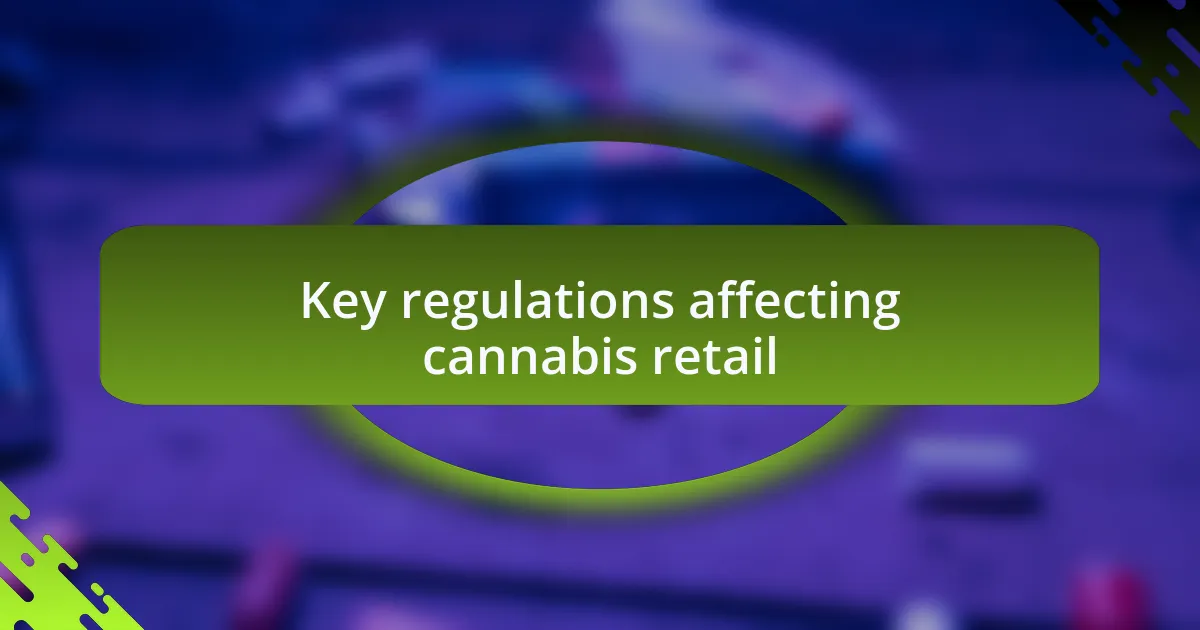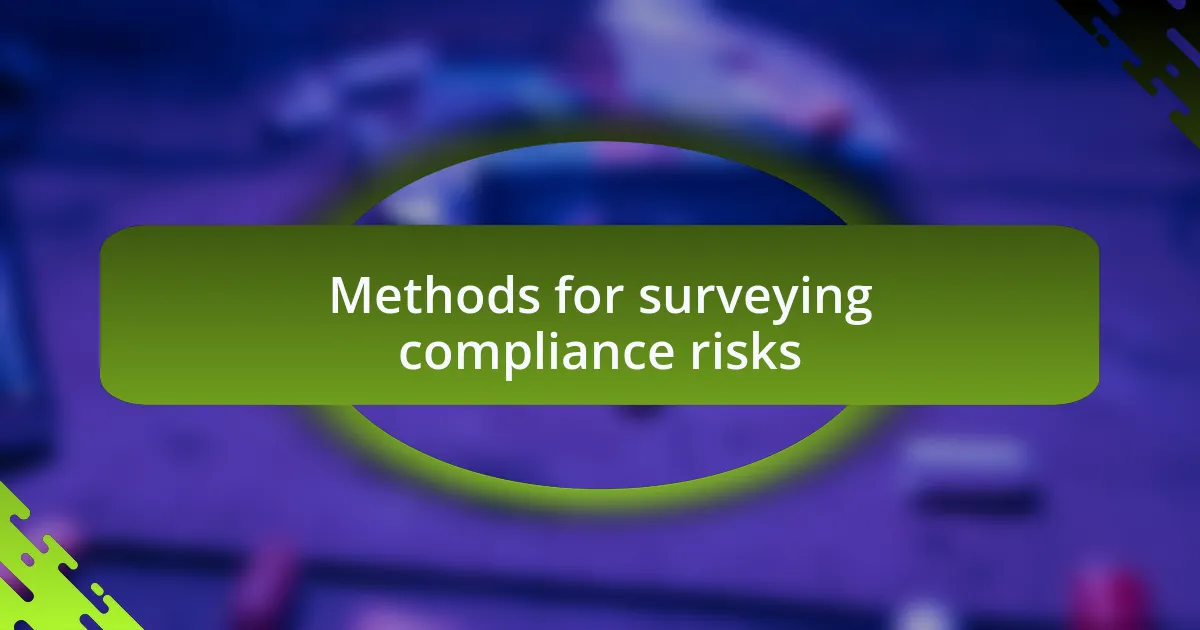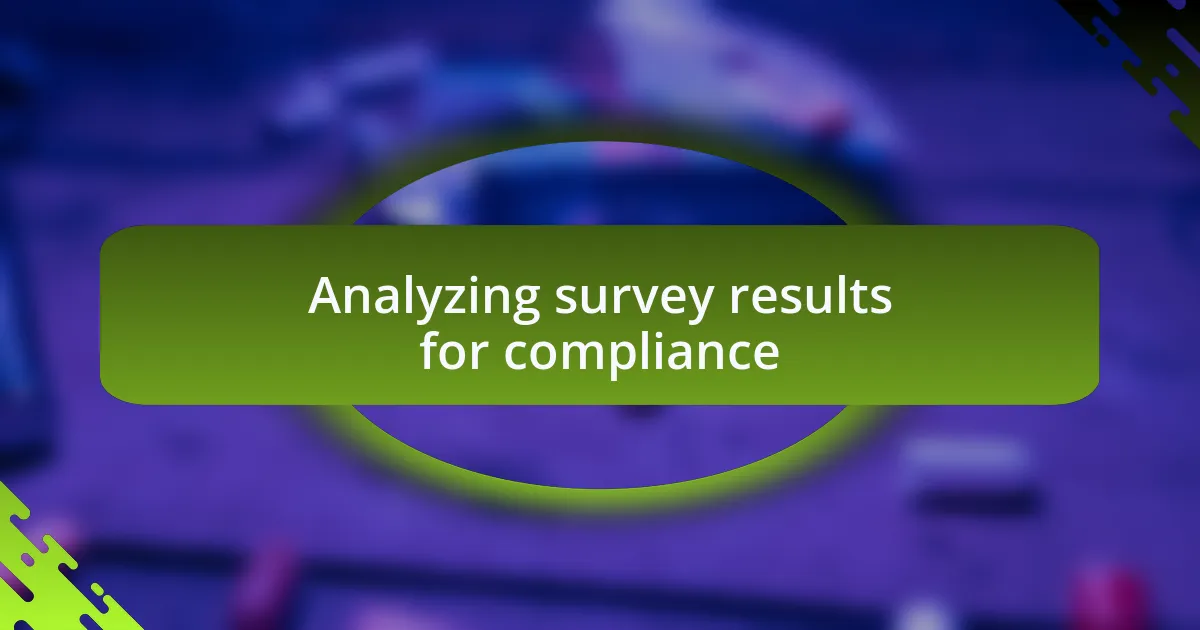Key takeaways:
- The Controlled Substances Act classifies cannabis as a Schedule I drug, creating compliance challenges for retailers balancing state and federal regulations.
- Effective compliance risk surveying combines qualitative methods, such as interviews, with quantitative techniques like audits and anonymous staff surveys to identify discrepancies in compliance culture.
- Analyzing survey results reveals gaps in employees’ understanding of compliance, highlighting the need for ongoing education and open communication within organizations.
- Personal interactions with employees are crucial for addressing compliance issues; fostering a supportive and engaging training culture is essential for ensuring adherence to regulations.

Key regulations affecting cannabis retail
One of the most significant regulations impacting cannabis retail is the framework established by the Controlled Substances Act. This federal law still classifies cannabis as a Schedule I drug, making compliance a complex balancing act for retailers who want to navigate both state and federal landscapes. I often wonder how retailers manage the tension between their local operations and federal restrictions—it’s no small feat.
In California, for example, the Bureau of Cannabis Control outlines specific licensing requirements that retailers must fulfill to operate legally. I remember speaking with a local cannabis retailer who emphasized the constant challenge of staying updated with these regulations. It’s not just about securing a license; it’s about understanding the nuances that can change overnight. This constant evolution raises the question: how well can businesses adapt to shifting regulations without sacrificing their integrity or customer trust?
Another aspect retailers can’t overlook is the strict regulations surrounding advertising and marketing. States often impose limitations on how cannabis products can be promoted, and for good reason—ensuring that the messaging isn’t targeting minors or promoting irresponsible use. As I reflected on this, I realized that while these rules can feel restrictive, they actually serve a larger purpose in protecting consumers and the community, fostering a responsible approach to a still-recently legalized industry.

Methods for surveying compliance risks
To effectively survey compliance risks in cannabis retail, I’ve found that a combination of qualitative and quantitative methods works best. I often start with in-depth interviews with employees and management to gain insights into their daily practices. This direct engagement uncovers nuances that aren’t always evident in the paperwork—like the stress a manager feels when juggling compliance with a busy sales floor.
Another method I rely on is conducting regular audits—both scheduled and surprise checks. These audits help to understand how well policies are being implemented on the ground. There’s something eye-opening about watching firsthand how a team responds to compliance protocols; it can be a mix of diligence and confusion. This dual perspective often leads me to ask: are the employees receiving enough training to feel confident in their roles, or are gaps in their knowledge putting the entire operation at risk?
Finally, I use surveys and feedback forms to gather anonymous insights from staff regarding the compliance climate. The importance of anonymity cannot be overstated; without it, I’ve noticed that many employees are hesitant to share their concerns. This approach has led to candid conversations that reveal not just compliance risks, but also areas where the company culture could better support adherence to these essential regulations. How can businesses truly thrive if the very team tasked with compliance feels unsupported?

Analyzing survey results for compliance
Once the surveys are collected, analyzing the results becomes a crucial step in understanding where compliance gaps exist. I remember going through one set of responses that revealed a shocking discrepancy between management’s perceived compliance culture and the frontline employees’ experiences. It struck me how often these discrepancies occur, making me wonder: how can leadership bridge this gap effectively if they’re unaware of these sentiments?
I focus on identifying trends that reveal not just isolated incidents but patterns that could indicate deeper systemic issues. For example, during one analysis, I noted that a significant percentage of employees felt uncertain about specific compliance rules concerning product safety. This clarity—or lack thereof—prompted me to reflect: are we educating our teams effectively, or are we merely assuming they understand compliance requirements?
Lastly, synthesizing the findings requires a blend of quantitative data and qualitative insights; each piece forms a bigger picture. I like to visualize it as constructing a puzzle—every survey response contributes another piece. I often ask myself, how can we transform numbers and percentages into actionable strategies? It’s about creating a narrative that not only diagnoses compliance risks but also drives meaningful change in the organization.

Personal experiences in compliance surveying
When I first delved into compliance surveying, I quickly realized the importance of connecting with employees on a personal level. During one site visit, I sat down with a few employees who felt uncomfortable discussing compliance issues openly. Their stories about navigating confusing protocols deeply resonated with me and highlighted the need for a more approachable way to address compliance. It made me think, how often do we overlook the voices that matter most?
In another instance, I encountered a compliance training session that fell flat. Participants seemed disengaged, and the discussions barely scratched the surface of real concerns. This experience taught me that compliance isn’t just about rules; it’s about fostering a culture of understanding and respect. I found myself questioning: how can we transform obligatory training into engaging conversations that empower employees to speak up?
As I reflect on these moments, I recognize that our compliance surveys are more than just data collection exercises; they are opportunities for genuine connection. Each response is a window into the experiences of individuals who protect our industry. I’ve learned to treat each survey as a conversation starter, inviting deeper dialogue. Are we truly listening to what our employees are saying, or are we just checking boxes? This mindset shift has become central to my approach in compliance surveying.